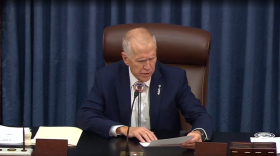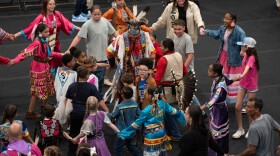In the final countdown to Election Day, the Trump and Biden campaigns turned attention to a swath of land just north of the South Carolina border and to the diverse people who live there.
Robeson County, a previous Democratic stronghold that favored Obama in 2008 and 2012 flipped in last week's election when President Trump enjoyed a robust lead over President-elect Joe Biden.
The county is the largest in North Carolina by land and is home to a unique mix of racially diverse residents. About one quarter of residents are Black, 30% are white, and over 40% are American Indian, largely members of the Lumbee Tribe, the largest American Indian tribe east of the Mississippi river.
After weeks of focused political messaging, including a last-minute Trump rally at the Robeson County Fairgrounds, residents had their say.
The county “moved the most towards Trump of any county of the hundred counties in the state of North Carolina,” according to Western Carolina University Political Science Department head Christopher Cooper.

Robeson County residents, who voted strongly for President Barack Obama in past elections, have now moved the needle in the complete opposite direction. And the data indicate the American Indian — majority Lumbee — population had a lot to do with President Donald Trump’s success in the area.
“Digging just a little bit deeper, and it looks like some of the most Native American heavy precincts were the ones that actually went the most for Trump,” Cooper said. “The 14 precincts in Robeson county that [are] majority Native American, twelve of them went for Donald Trump. And the two exceptions tend to be pretty small precincts.”
In 14 of Robeson County's 19 precincts that delivered the biggest margin of victory for Trump, American Indians make up at least 45% of the population, according to preliminary election results and voter precinct demographic data, both from the N.C. Board of Elections. The remaining five precincts were at least 55% white. In all of those precincts, Blacks made up less than a quarter of the population. The seven precincts that voted for Biden were all at least 46% Black. The precinct that delivered the biggest margin for Biden is 76% Black and only 4% white.
In the leadup to the election, both Trump and Biden made statements supporting full federal recognition for the Lumbee Tribe. The tribe, which received state recognition in 1885 and partial federal recognition in 1956, has been vying for full federal recognition for decades. That status would mean access to millions in federal funding, and the potential for a casino down the line.
Trump doubled down on his focus on the community with a rally in Lumberton, the county seat, at the end of October.
“I think it might have mattered at the margins,” said Cooper. “Putting time, which is the most valuable resource the candidate has, into a specific place shows interest, perhaps more so than anything else.”
Retired public school teacher and Lumbee Tribe member Anthony Locklear reflected on the impact of that Trump rally and what it meant for the community.
"People recognized our university. [Trump] asked the chancellor to stand. He's a former classmate of mine, so I'm real proud of that. Anytime the president comes to your county, it's a big, major thing, whether you're a Trump person or not,” said Locklear before the election, referring to the historically Lumbee University of North Carolina at Pembroke.
Political scientist Christopher Cronin of Methodist University in nearby Fayetteville, says civil rights issues are one of the ways the Lumbee community in particular has aligned with Democrats’ policies and values. But Lumbee voters also tend toward the cultural conservative values and economic populism of Republicanism. These layered values seem to show up in how the county has voted historically.
In the past, the community was a Democratic stronghold. In 2008, Robeson County favored Obama by a 14 percentage point margin over Republican Sen. John McCain. In 2012, that preference for Obama actually increased – an anomaly compared with many areas around the country. Robeson County delivered Obama an 18 percentage point victory over Republican Mitt Romney in a year in which the state as a whole swung back in favor of the Republican candidate.
Just two elections later, that completely flipped. In 2020, it was President Trump who enjoyed an 18-point margin in the county over President-elect Joe Biden.
Another takeaway, Cooper explains, is that Native American voters are no monolith in the state. In the most heavily Native American precincts in the Western part of the state where the Eastern Band of Cherokee Indians are based, Trump did not make these kinds of gains. And in one heavily-native American precinct in Swain County, Biden took the lead.
“The national media, the state media, and even the local media should not treat Native Americans as if they are one group with one monolithic set of political attitudes, opinions or behaviors,” said Cooper. “Matter of fact, we've got very different patterns within the very same state.”











